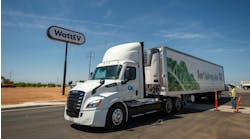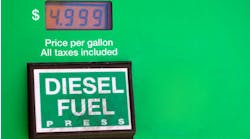Fleets can significantly trim their idle times with an investment in the right combination of technologies, resulting not only in financial savings but higher driver retention and an improved “green” image.
Those were among the key findings of the latest confidence report on idle-reduction technologies from the North American Council on Freight Efficiency (NACFE).
"By investing in technologies and practices, fleets can reduce idle to well below 20%. The challenge is figuring out which set of technologies are best for you and being diligent in making it work,” said Mike Roeth, executive director of NACFE.
To operate their sleepers, U.S. fleets used over 1 billion gallons of diesel while idling in 2017, or about 8% of the total fuel burned. A 10% reduction in idling is worth about 1% in fuel economy, translating to about $500- $700 in savings at $3 a gallon diesel and traveling 100,000 miles a year.
NACFE’s report, released July 30, explores anti-idling options including fuel-operated heaters, diesel APUs, battery HVAC systems, automatic engine start/stop systems and driver behavior as among the main solutions to idling. It also covers ways to enhance idle-reduction efforts, such as cab insulation and light-colored paint.
The group found the most efficient and effective solution for a fleet involves a combination of complementary idle-reduction technologies used together. The four best “anchor” technologies to build around are driver controls + fuel-operated heaters, diesel APU + fuel-operated heater, battery HVAC + fuel-operated heater, and automatic engine start/stop system.
The right combination will depend on a given fleet’s routes, fuel costs, climate in the area of operation, shop costs, maintenance cycles, training methods, driver support, fleet policies and other factors.
Though many technologies are available and proven, each has pros and cons, NACFE said. Despite overall adoption being fairly low, the need to meet federal regulations and/or sustainability goals are reasons idle-reduction technologies are expected to gain greater acceptance in the coming years.
NACFE noted it initially published a report on idle-reduction technologies back in June 2014, when diesel was closer to $4 a gallon. With current pump prices significantly lower, payback times are extended.
However, the group said investments in idle-reduction technologies can aid in driver retention, by offering them a higher level of comfort during rest periods, allowing them to more easily use computers, microwaves and other devices without having the engine running.
During a media conference call, Roeth noted more drivers expect fleets to take steps to reduce noise and vibration in the cab, such as investing in idle-reduction technologies. NACFE also pointed out if the main engine will need to idle for the entire restart period to maintain comfortable temperatures, a hotel room or dormitory may be a more cost-effective choice for the fleet, and a preferable option for the driver.
The report includes a confidence matrix and payback calculator, allowing fleets to estimate the payback in months for various idle-technology solutions.



